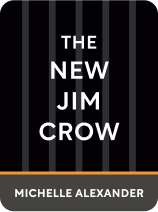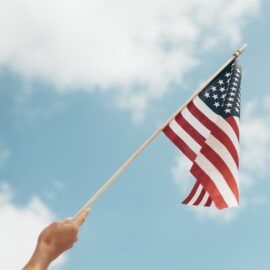

This article is an excerpt from the Shortform summary of "The New Jim Crow" by Michelle Alexander. Shortform has the world's best summaries of books you should be reading.
Like this article? Sign up for a free trial here .
What is a racial caste system? Is there a racial caste system in the US?
The racial caste system is a social hierarchy based on race. White elites support institutions that cement their higher status and fend off the threat of black ascension.
Read on to understand the racial caste system as The New Jim Crow discusses it.
Racial Caste System: The New Jim Crow
The three major waves of racial discrimination in the United States – slavery, Jim Crow, and the war on drugs – show a pattern of genesis and implementation:
- White elites committed to the racial caste system worry about a threat to the social order.
- They devise a new method of enforcing racialized social control.
- They collapse resistance across the political spectrum, largely by appealing to the vulnerability of lower-class whites.
- The system becomes institutionalized and pervasive, as stakeholders pursue their own incentives and rationalize their behavior.
Let’s follow the pattern:
Slavery in the American Colonies
1) White elites committed to racial hierarchy worry about a threat to the social order.
- The colonies had to deal with the contradiction between the ideals of freedom in the colonies vs slavery and the extermination of American Indians.
- One way to deal with this: stereotype American Indians as a savage lesser race. This offers less of a moral problem when eliminating them to expand land.
- In Virginia in 1675, Nathaniel Bacon is denied militia support by the planter elite for seizing Native American lands. He organizes a rebellion, allying poor whites, indentured servants, and slaves, united in condemnation of the rich’s oppression. The rebellion is ended by force, but word of it spreads wide. The idea of whites and blacks uniting to overthrow the elites is terrifying.
2) They devise a new method of enforcing racialized social control.
- They lessen their reliance on white indentured servants and import more slaves from Africa who are less likely to form alliances.
- Stereotyping Africans as a lesser race, lacking in intelligence and laudable qualities, rationalized the enslavement. It allows consistency with the new American ideals of liberty, because in this view Africans aren’t really humans who deserved freedom.
- Racism is built into the constitution – slaves are defined as ⅗ of a man. Federalism protects states’ rights to slavery.
3) They collapse resistance across the political spectrum, largely by appealing to the vulnerability of lower-class whites.
- The planter class extends special privileges to poor whites to distinguish them from black slaves. Privileges include greater access to Native American lands and allowing policing of slaves.
4) The system becomes institutionalized and pervasive, as stakeholders pursue their own incentives and rationalize their behavior.
- Due to the “racial bribes,” poor whites now have a personal stake in the maintenance of a race-based system of slavery.
- The planter elites obviously have deep incentives to maintain slavery to enjoy their low labor costs.
- White supremacy becomes a religion of sorts – “whites are superior to blacks, and slavery is for the blacks’ own goods.” Cognitive dissonance reinforces these beliefs – “if I’m a slave owner, and yet I also believe in American liberty, then African inferiority must be true.”
Jim Crow and the Racial Caste System
1) White elites committed to racial hierarchy worry about a threat to the social order.
- The Civil War, Emancipation Proclamation, and 13th Amendment formally end slavery. Civil RIghts Act of 1866 gives African Americans full citizenship.
- Freed black people provoke fears of danger, and amalgamation with beings considered inferior and vile.
- Poor whites are frightened of losing their social status accorded by skin color.
- The Populist Party accuses the privileged classes at conspiring to keep poor whites and blacks locked into subjugation. “You are made to hate each other” for “financial despotism that enslaves you both.” Racial integration and class-based unity is a centerpiece. The Populists achieve political success.
2) They devise a new method of enforcing racialized social control.
- Mainly this: Segregation laws are proposed to split poor whites and African Americans. Segregation leads poor whites to retain a sense of superiority over blacks, making alliances unlikely.
- A system of veiled slavery is enacted. 1) States enact convict laws allowing for hiring out-of-county prisoners for little pay. 2) Very tough vagrancy laws (like requiring jobs for all freed black people) create lots of convicts. Treatment is possibly worse than slavery, given that employers are merely temporary, unlike plantation owners. This fades out gradually in the early 20th century.
- States impose poll taxes, literacy tests, and other barriers to prevent black voting.
- The Ku Klux Klan enacts terrorist campaigns against Reconstruction governments and leaders.
3) They collapse resistance across the political spectrum, largely by appealing to the vulnerability of lower-class whites.
- Conservatives implement campaigns of white supremacy, directing poor white hatred at blacks instead of white elites. This shields elites from a mass uprising from the poor.
- The agricultural depression promotes “permission to hate” and scapegoats blacks.
4) The system becomes institutionalized and pervasive, as stakeholders pursue their own incentives and rationalize their behavior.
- Politicians compete with each other by proposing more stringent and oppressive legislation (like prohibiting blacks and whites from playing chess).
The War on Drugs and the New Jim Crow
The pattern shown centuries earlier is repeated in the 1960s, creating the racial caste system in The New Jim Crow lasting to the present day.
1) White elites committed to racial hierarchy worry about a threat to the social order. That’s where the racial caste system in The New Jim Crow comes in.
- World War II highlights a contradiction between opposing Nazi racial persecution and continued racial segregation in the US. You can’t fight the Nazis on grounds of racial equality while also segregating in the United States.
- There is also concern that blacks without equality would become susceptible to communist ideals.
- In 1954 Brown vs Board of Education abolishes “separate but equal,” to much outrage in the South.
- The Civil Rights Movement in the 60s leads to the Civil Rights Act of 1964 and Voting Rights Act of 1965, which reduce discrimination in employment, education, and voting.
- Realizing the depth of the poverty trap, civil rights activists attack discrimination in economic opportunities, looping in poor working-class whites who face similar issues.
2) They devise a new method of enforcing racialized social control.
- Whatever the method was, it now has to be race-neutral and cannot involve explicit racial discrimination.
- The solution is “law and order” and “cracking down on crime.”
- This rhetoric started in the 1950s condemning actions of the more militant civil rights activists. Riots, like those following the assassination of MLK, fuel this image. Supporting racial integration is cast as condoning lawlessness.
- Incidentally, the FBI reports increases in crime in the 1960s. The author argues this is due in large part to the baby boom generation, since most crimes are committed by the 15-24 age group. But advocates of cracking down on crime use this to increase the urgency of their messaging.
- The rhetoric has clear racial undertones – says WV senator, “if [blacks] conduct themselves in an orderly way, they will not have to worry about police brutality.”
3) They collapse resistance across the political spectrum, largely by appealing to the vulnerability of lower-class whites.
- Lower-class whites bear a larger cost of integration since they compete with blacks for jobs and status. (The wealthy white liberals who support integration are criticized as “sheltered” from the costs of integration and out of touch.) They oppose integration, are frustrated with the Democratic party’s support of civil rights, and flock to the Republican party.
- Brief history lesson: after the Civil War, the South is Democratic and the North is Republican. The Great Depression leads to widespread economic support in the New Deal, by Democrat FDR. This gets support among urban ethnic groups and white South into the 1960s.
- With resentment among poor whites for racial reform, conservative Republican strategists see an opportunity to create a “new majority” among the white South and blue-collar whites in cities. Nixon apparently says, “the whole problem is really the blacks. The key is to devise a system that recognizes this while not appearing to.” Nixon appeals to the anti-black voters with cracking down on crime.
- The Republicans want to stir a racially polarized environment and help create a black Democratic party, which will drive anti-black whites into the Republican party. Ironically, they thus even support some civil rights efforts to further increase friction.
- To stoke the flames against integration, conservative rhetoric creates stereotypes of “welfare queens” and accuses black people of only having themselves to blame for poverty. This makes poor whites further resent integrated blacks.
- Thus political disagreements shift from economic grounds in the 50s to racial grounds in the 70s, breaking up the Democratic coalition of white and black voters.
- Even black activists join the call for “law and order,” shielding conservatives from accusations of racial discrimination – say conservatives, “if we have black support, we can’t possibly be racist.”
- Reagan continues the rhetoric on criminal “predators” and “welfare queens,” all in implicitly racial language.
4) The system becomes institutionalized and pervasive, as stakeholders pursue their own incentives and rationalize their behavior.
- In 1982, Reagan starts the War on Drugs, even though less than 2% of the American public view drugs as the most important issue. In 1989, this has risen to 64%.
- Crack cocaine reaches its height in 1985, ravaging urban neighborhoods affected by outsourcing of manufacturing jobs.
- Federal antidrug funding grows by a literal 10x in the FBI, DoD, and DEA over a decade, while funding for substance abuse counseling is cut.
- The DEA supports media campaigns for the crack epidemic. The media are happy to oblige since this is the “hottest combat reporting since the end of the Vietnam War.”
- Racially coded language about “crack whores” and “gangbangers” reinforce stereotypes of lazy welfare queens and black criminal predators.
- Politicians campaign on promises of being tough on crime and drugs, motivated by the desire to win and appealing to constituents.
- With the media rage, few politicians dare to stand against “cracking down on crime.” Instead, they scramble over each other to seem the harshest against crime. (This had also occurred during Jim Crow segregation, with some politicians proposing legislation against integrated chess playing.)
- With the Anti-Drug Abuse Act of 1986, mandatory minimum sentences are passed. Punishments are more severe for crack (associated with blacks), requiring 5g of possession, vs 500g of powder cocaine (associated with whites). More civil penalties are passed.
- George Bush Sr employs the famous Willie Horton ad with a black man who escaped on a work furlough and raped and murdered a white woman. He continues rhetoric of drug use as “the most pressing problem.”
- In response, Democrats want to take back voters.
- In 1992, Bill Clinton vows no Republican will be as tough on crime as he. He passes the “three strikes and you’re out” law, mobilizes $30 billion in anti-crime funding, eliminates welfare and federal public housing for drug felons, and increases funding for state prisons.
- Ironically Bill Clinton is famously popular among black voters, despite passing laws that will ultimately harm black communities.
- Obama expands funding for anti-drug programs for economist stimulus and appoints staff members (Biden, Emanuel) who are tough on drugs.
- This could be political maneuvering for bigger personal goals, like Obamacare.
- Concerns about crime and drugs are weakly correlated with actual crime rates, and more strongly correlated with political campaigns.
- White voters are given a forum to express hostility to black progress without being accused of racism. Also, spurred by media sensationalism and political campaigns, fear drives support for tough policies.
- Once given a healthy dose of funding, prisons (public and private) and federal agencies (DEA, FBI) are reluctant to regress. They continue the lobbying and rhetoric to reinforce the feeling of danger.
- Judges and the Supreme Court uphold legality of police activities like pretext stops and barring evidence of discrimination from being considered in court (eg McCleskey v Kemp). These are likely primarily out of case precedent and not explicitly politically biased.
- But it’s hard not to think they were at least a little influenced by the zeitgeist of the day, the government mandate for war on crime.
- Lower courts then have to follow the case law and strike down attempts to claim discrimination in court.

———End of Preview———
Like what you just read? Read the rest of the world's best summary of Michelle Alexander's "The New Jim Crow" at Shortform .
Here's what you'll find in our full The New Jim Crow summary :
- How the US prison population increased 10x in 30 years because of harsh drug policies
- How being "tough on crime" was deeply motivated in discrimination against black people
- Why being convicted for a crime is essentially a life sentence of poverty and return to prison







A great contextual read, spun along an accurate historical timeline… it fills in the omissions of content purposefully redacted in USA history books!